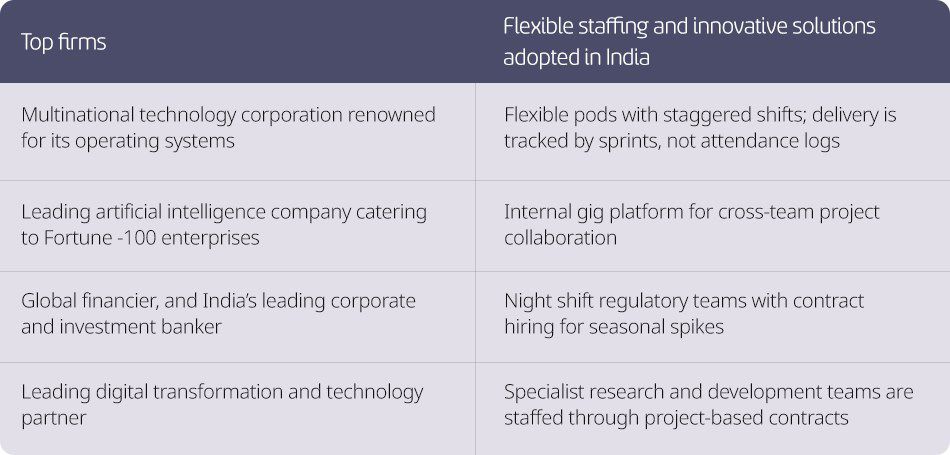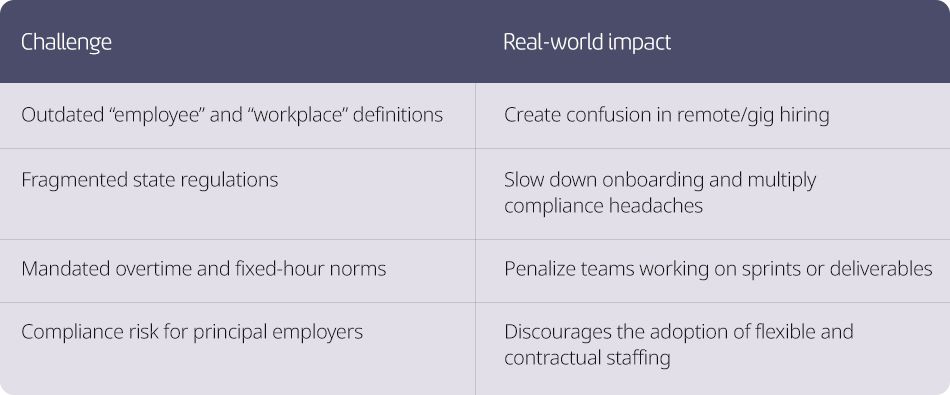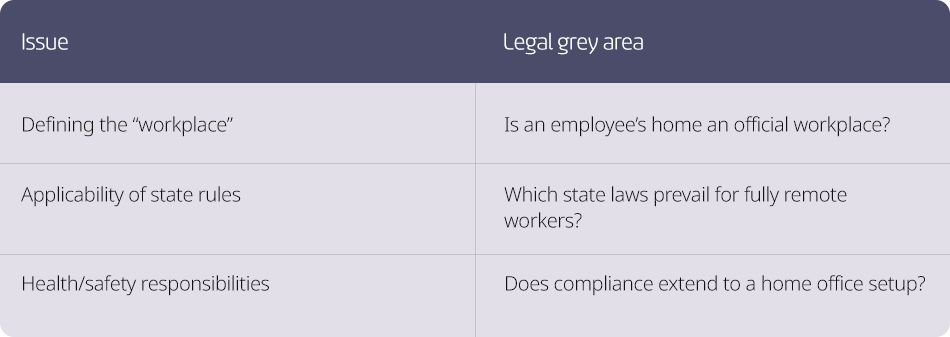You are viewing India’s website

Why the 9-to-5 model is dead for new-age companies in India: Steps GCCs can take to support new-age workplaces
A few months ago, during a closed-door HR leadership roundtable in Bengaluru, a chief human resource officer (CHRO) from a top-tier global capability center (GCC) made a sharp comment: “We’re expected to build a 24/7 global talent engine in India in 2025 and beyond using labor laws written in the 1970s.”
It stayed with me. Because it’s not just true — it’s the reality of CHROs in India. The traditional 9-to-5 model, once the gold standard of white-collar work, is now a relic for high-growth and high-compliance environments.
Changing face of work: Beyond the 9-to-5
The classic 9-to-5 schedule has rapidly lost relevance for India’s new-age companies, especially among startups and GCCs. With over 1,900 GCCs and 159,000+ recognized startups by the Department for Promotion of Industry and Internal Trade driving innovation in India, the focus has decisively shifted toward flexibility, agility, and results, not clock-watching.
1. Staff augmentation is powering flexibility
Excessive focus on attendance and overtime hinders the implementation of flexible, output-based schedules that staff augmentation enables. Today’s leading companies embrace staff augmentation for greater adaptability and access to specialist talent. It required blending full-time staff with freelancers, gig workers, and short-term contractors. Project-based, sprint-oriented teams and internal gig platforms enable organizations to:
• Scale rapidly for new initiatives or seasonal peaks
• Bring specialized skills on board efficiently
• Maintain agility without the overhead of permanent hiring
Examples: How top firms are innovating


2. Gen Z and Gen Alpha are pushing the envelope for work-life balance
India’s Gen Z and Gen Alpha workforce expects flexibility as a default, not a perk. They choose roles that offer autonomy, outcomes-based evaluation, and room for personal growth. Companies unwilling to move beyond traditional labor paradigms risk missing out on this generational wave of talent.
Gen Z and future-ready startups are offering options for life beyond work and flexibility to operate from new-age workplaces: these are the cultural demands to attract raw talent. It’s the only way to compete in an era of global talent, digital disruption, and ever-evolving skills.
3. Alternative work locations are the key
The last few years have rewritten the rules of where work happens for Indian companies. Today, high-growth startups and GCCs experiment with work-from-office, work-from-home, and truly hybrid arrangements. Employee surveys and hiring trends show these models are here to stay, especially for tech, data, and compliance roles.
Also read: High tech marrying high touch: The future of HR outsourcing
The labor law conundrum: Where the rules lag behind
Despite business transformation, India’s labor laws remain relics of a bygone era. They are designed around traditional, permanent employment, which clashes with the needs of modern companies.
Definitions ignore a large chunk of the workforce
Rigid definitions restrict recognition of freelancers and gig workers under most statutes, making it risky for employers to try new models. State-level fragmentation means a policy change in one state could affect operations everywhere. Excessive focus on attendance and overtime hinders the implementation of flexible, output-based schedules that staff augmentation enables.
Real-world impact of challenges faced


An urgent need to redefine the workplace
However, India’s current labor laws struggle to keep up with the “change in scenario” and the need to work “from my own space” for today’s employees.
• Rigid definitions: Most statutes define “workplace” strictly as a physical office, ignoring remote and distributed teams.
• Attendance-focused compliance: Rules on attendance, overtime, and record-keeping were designed for in-office employees — these fail for those working remotely or flexibly.
• Ambiguous applicability: It is often unclear which state’s labor laws apply if a remote employee works from a different location than the company office.
Examples: Legal ambiguities in remote/hybrid work


Navigating forward: Compliance meets flexibility
To thrive, companies must get creative, employing solutions that protect agility while ensuring tight compliance.
How leaders are responding:
• HR outsourcing partners: Specialists help navigate pan-India compliance, digital wage filings, and regular audit needs.
• Digitized compliance: Platforms like TP Total Talent create digital trails to manage documentation, reporting, and multi-state compliance.
• Hybrid “talent stack”:


Also read: Exploring the synergies between modern BPM organizations and HR services
How staff augmentation bridges the gap
Staff augmentation provides a flexible and pragmatic solution to these legal ambiguities:
• Clearer contracts: Contractors, freelancers, and gig workers operate under commercial arrangements, not traditional employment contracts. This allows for explicitly stated expectations regarding work location and outcomes.
• Specialist providers: Many staff augmentation firms take on statutory employer responsibilities, ensuring compliance across diverse locations, so companies don’t have to navigate state-by-state grey zones independently.
• Scalable models: Companies can test hybrid or fully remote teams for specific projects and quickly scale up or down as needed without being encumbered by rigid in-office requirements.
Until India’s labor codes modernize to reflect hybrid realities, staff augmentation remains crucial, giving companies legal clarity and operational flexibility to build distributed, future-ready teams.
Conclusion
India’s labor law landscape needs urgent modernization — but until then, savvy companies blend regulatory caution with new staff augmentation models. The winners will be those who decode the “how” to remain compliant while building the most adaptive, energized teams in the world.
#FutureOfWork #GCCsIndia #FlexiStaffing #HRO #HRTransformation #LaborLaws #MyHR #TPInsights
Other impactful stories
- Insightful Articles
